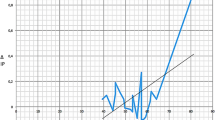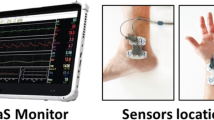Abstract
Cardiovascular adaptations to pregnancy involve physiological mechanisms that increase cardiac output, decrease total vascular resistance, and decrease both systolic and diastolic blood pressure (BP). These maternal hemodynamic changes modulate uteroplacental blood flow and fetal–placental Doppler indices. Our objective was to create maternal cardiac profiles of pregnant women using non-invasive measurements of central BP to identify changes in maternal–fetal hemodynamics as a surrogate to fetal status. This was a prospective cohort study of all singleton pregnancies in a perinatal referral center between January and April 2018. Central BP was measured non-invasively using the BP+ device. The BP+ device is a supra-systolic oscillometric central BP device, which measures BP waveforms peripherally and calculates central BP. We compared various BP+ values for peripheral BP with central BP and stratified by gestational age. We investigated the correlations between peripheral BP, central BP, estimated fetal weight (EFW), and the pulsatility indices (PI) of Doppler velocimetry and demonstrate that both central systolic and diastolic BP correlated to peripheral systolic and diastolic BP. Linear regression analysis confirmed that central BP predicts the middle cerebral artery (MCA) PI. The MCA PI correlated with EFW, specifically higher central systolic BP is associated with a lower MCA PI, implying a possible etiology of fetal brain shunting with poor placental perfusion. Future studies using predictors and markers of fetal outcomes from maternal cardiac parameters should consider maternal cardiovascular measurements to peripheral arterial BP.




Similar content being viewed by others
References
Duvekot JJ, Peeters LLH. Maternal cardiovascular hemodynamic adaptation to pregnancy. Obstet Gynecol Surv. 1994;49(12):S1–S14.
Christianson RE. Studies on blood pressure during pregnancy: I. Influence of parity and age. Am J Obstet Gynecol. 1976;125(4):509–13.
Clapp JF 3rd, Capeless E. Cardiovascular function before, during, and after the first and subsequent pregnancies. Am J Cardiol. 1997;80(11):1469–73.
Canobbio MM, Warnes CA, Aboulhosn J, et al. Management of pregnancy in patients with complex congenital heart disease: a scientific statement for healthcare professionals from the American Heart Association. Circulation. 2017;135(8):e50–87.
Naeye RL. Maternal blood pressure and fetal growth. Am J Obstet Gynecol. 1981;141(7):780–7.
Lim WY, Lee YS, Tan CS, et al. The association between maternal blood pressures and offspring size at birth in Southeast Asian women. BMC Pregnancy Childbirth. 2014;14:403.
Szczepaniak-Chichel L, Markwitz W, Tykarski A. Difference between central and peripheral blood pressure in healthy and hypertension-complicated pregnancy. Blood Press Monit. 2016;21(2):103–10.
Easterling TR, Benedetti TJ, Carlson KC, Brateng DA, Wilson J, Schmucker BS. The effect of maternal hemodynamics on fetal growth in hypertensive pregnancies. Am J Obstet Gynecol. 1991;165(4 Pt 1):902–6.
Vasapollo B, Valensise H, Novelli GP, Larciprete G, di Pierro G, Altomare F, et al. Abnormal maternal cardiac function and morphology in pregnancies complicated by intrauterine fetal growth restriction. Ultrasound Obstet Gynecol. 2002;20(5):452–7.
Tomsin K, Mesens T, Molenberghs G, Peeters L, Gyselaers W. Characteristics of heart, arteries, and veins in low and high cardiac output preeclampsia. Eur J Obstet Gynecol Reprod Biol. 2013;169(2):218–22.
Ferrazzi E, Stampalija T, Monasta L, Di Martino D, Vonck S, Gyselaers W. Maternal hemodynamics: a method to classify hypertensive disorders of pregnancy. Am J Obstet Gynecol. 2018;218(1):124.e121–11.
Roman MJ, Devereux RB, Kizer JR, Lee ET, Galloway JM, Ali T, et al. Central pressure more strongly relates to vascular disease and outcome than does brachial pressure: the Strong Heart Study. Hypertension. 2007;50(1):197–203.
Roman MJ, Devereux RB, Kizer JR, Okin PM, Lee ET, Wang W, et al. High central pulse pressure is independently associated with adverse cardiovascular outcome the strong heart study. J Am Coll Cardiol. 2009;54(18):1730–4.
McGee WT, Mailloux P, Jodka P, Thomas J. The pulmonary artery catheter in critical care. Semin Dial. 2006;19(6):480–91.
Climie RE, Schultz MG, Nikolic SB, Ahuja KD, Fell JW, Sharman JE. Validity and reliability of central blood pressure estimated by upper arm oscillometric cuff pressure. Am J Hypertens. 2012;25(4):414–20.
Lowe A, Harrison W, El-Aklouk E, Ruygrok P, Al-Jumaily AM. Non-invasive model-based estimation of aortic pulse pressure using suprasystolic brachial pressure waveforms. J Biomech. 2009;42(13):2111–5.
Lin AC, Lowe A, Sidhu K, Harrison W, Ruygrok P, Stewart R. Evaluation of a novel sphygmomanometer, which estimates central aortic blood pressure from analysis of brachial artery suprasystolic pressure waves. J Hypertens. 2012;30(9):1743–50.
Roberts LA, Ling HZ, Poon LC, Nicolaides KH, Kametas NA. Maternal hemodynamics, fetal biometry and Doppler indices in pregnancies followed up for suspected fetal growth restriction. Ultrasound Obstet Gynecol. 2018;52(4):507–14.
Fujime M, Tomimatsu T, Okaue Y, Koyama S, Kanagawa T, Taniguchi T, et al. Central aortic blood pressure and augmentation index during normal pregnancy. Hypertens Res. 2012;35(6):633–8.
Spasojevic M, Smith SA, Morris JM, Gallery ED. Peripheral arterial pulse wave analysis in women with pre-eclampsia and gestational hypertension. Bjog. 2005;112(11):1475–8.
Poiati JR, Peracoli JC, Magalhaes CG, Costa RA, Oliveira AP, Borges VT. OS097. Hemodynamic assesment by applanation tonometry in women with early and late preeclampsia. Pregnancy Hypertens. 2012;2(3):231.
Author information
Authors and Affiliations
Corresponding author
Rights and permissions
About this article
Cite this article
Woods, A., Afshar, Y., Yin, O. et al. Maternal Central Blood Pressure Is Associated with Fetal Middle Cerebral Artery Dopplers. Reprod. Sci. 27, 655–661 (2020). https://doi.org/10.1007/s43032-019-00069-6
Received:
Accepted:
Published:
Issue Date:
DOI: https://doi.org/10.1007/s43032-019-00069-6




